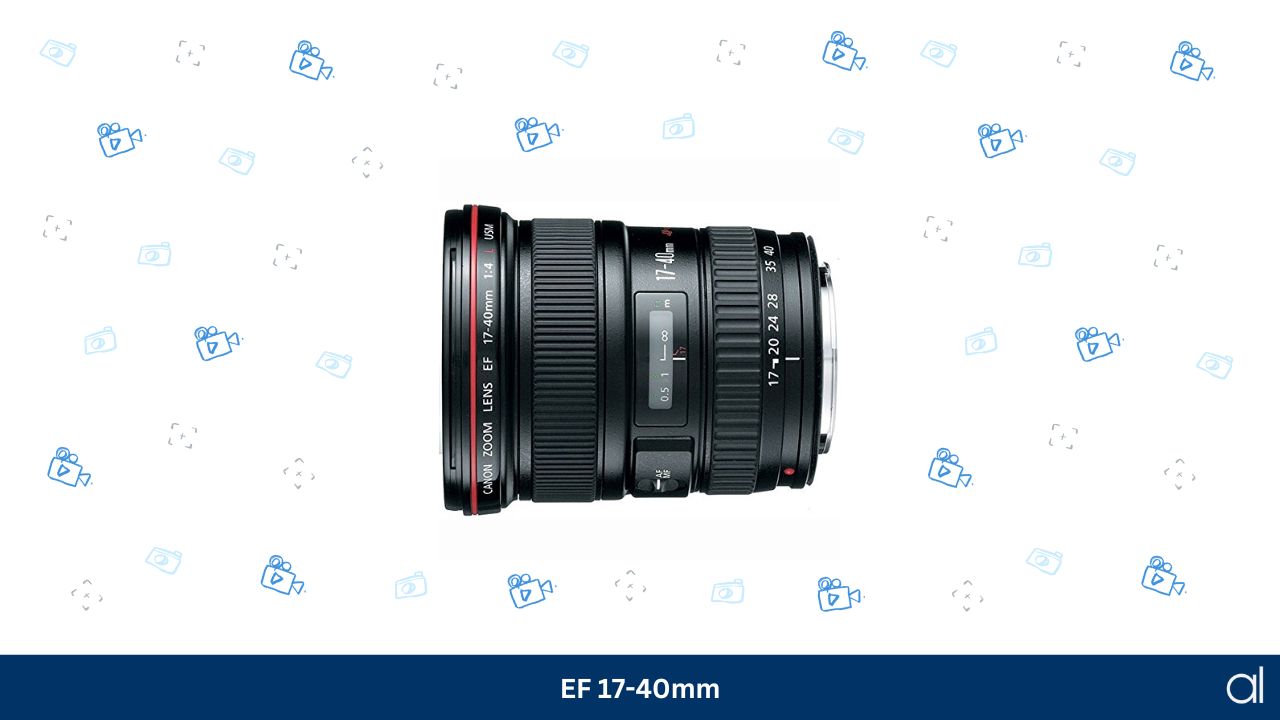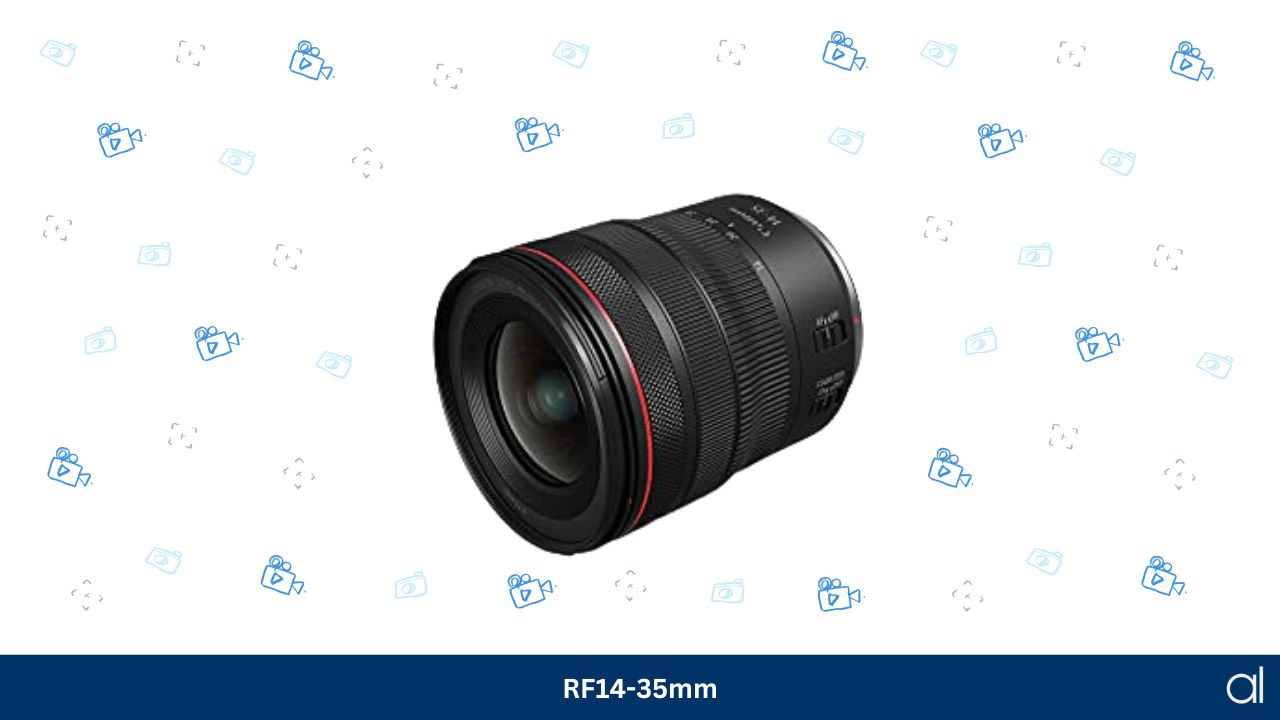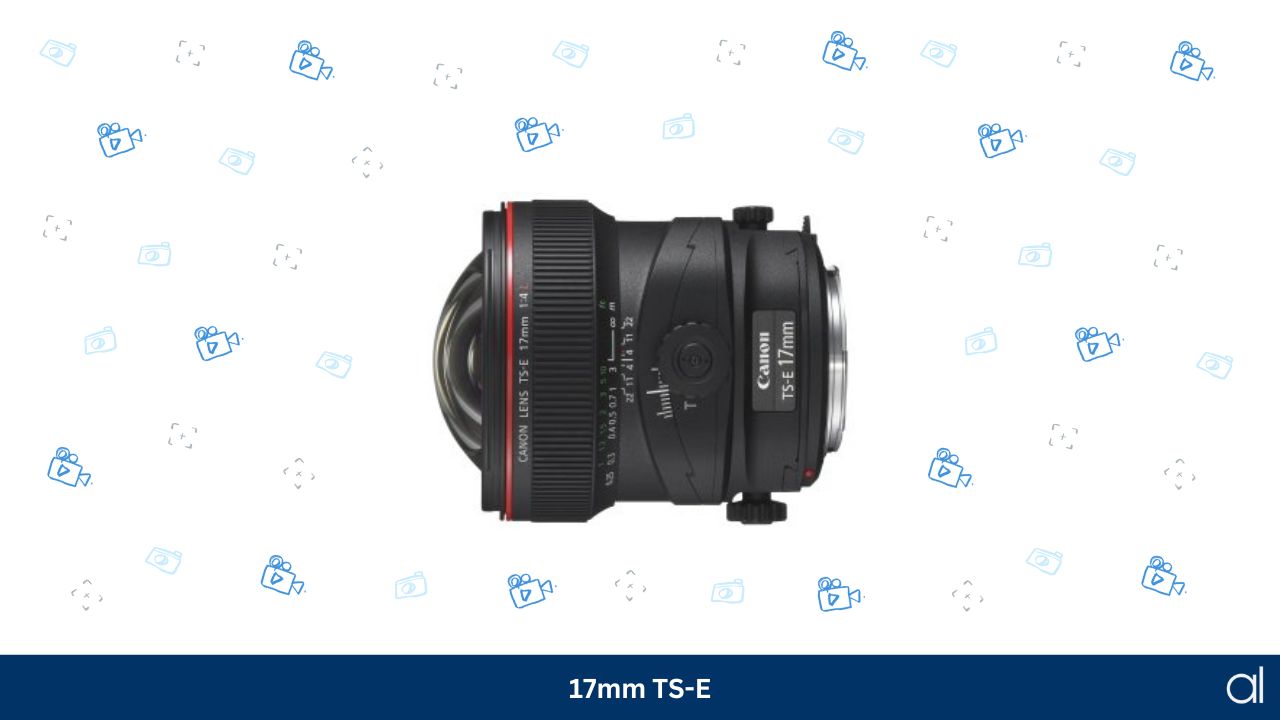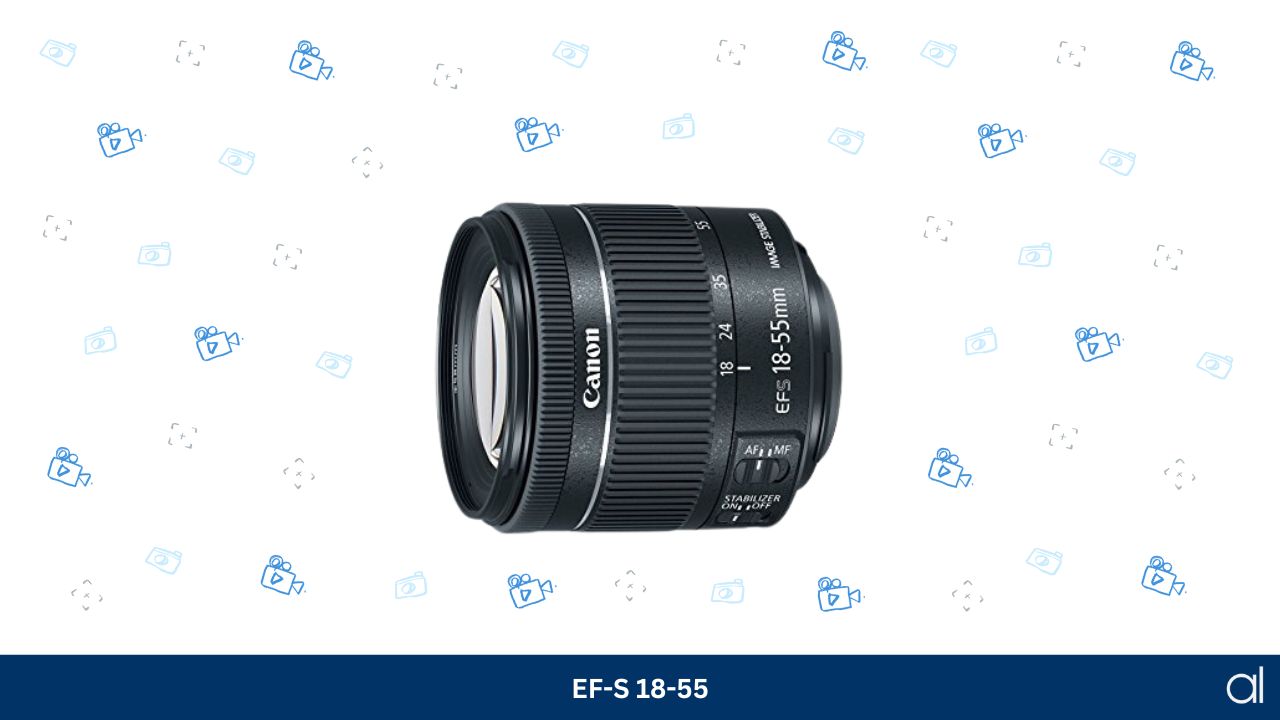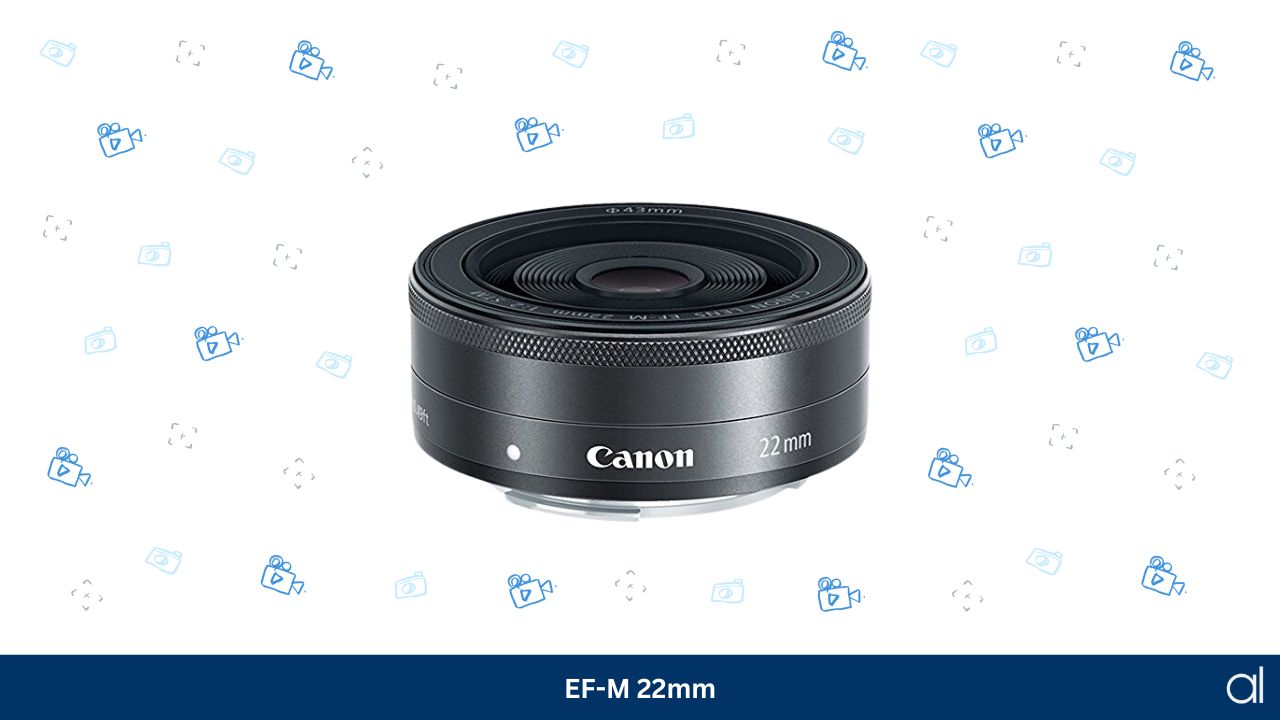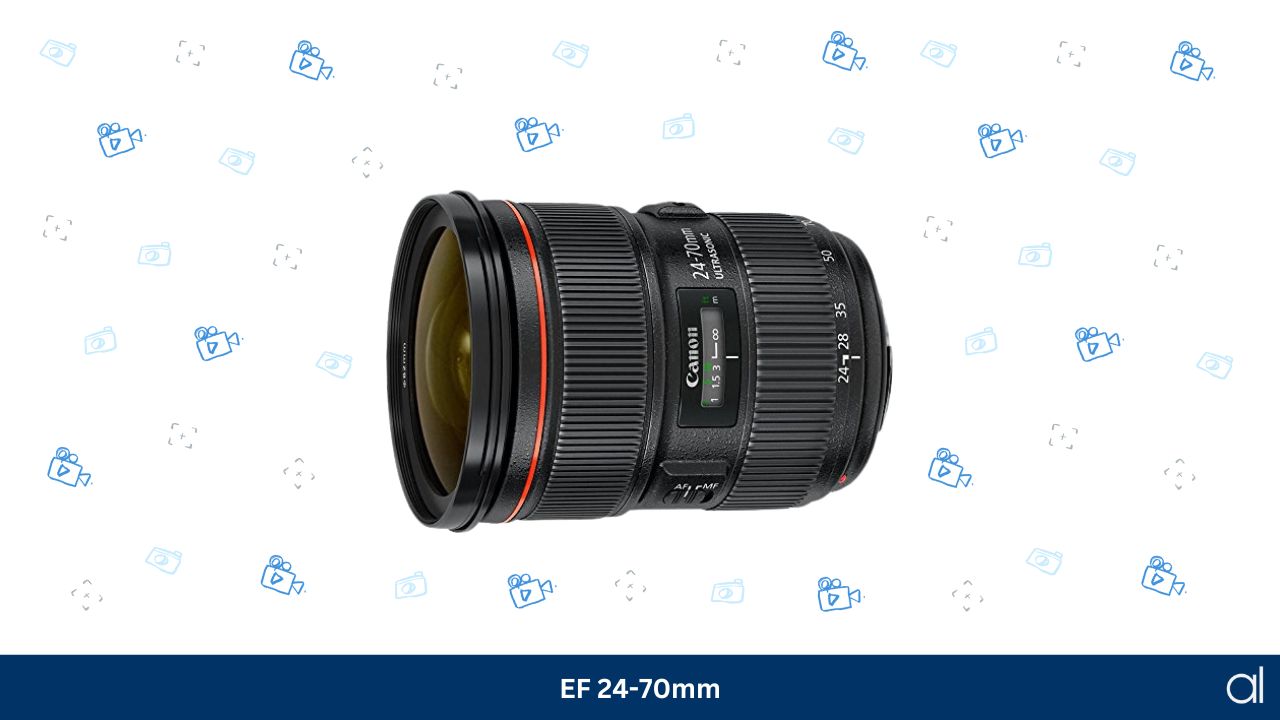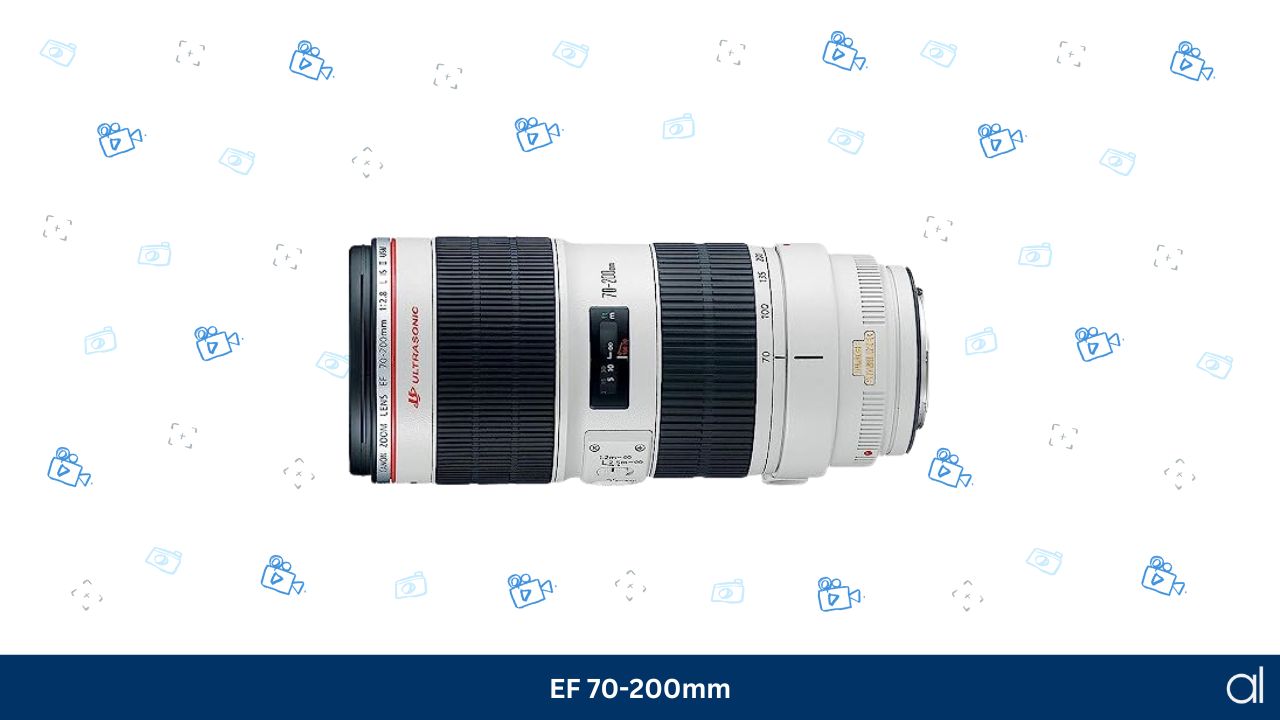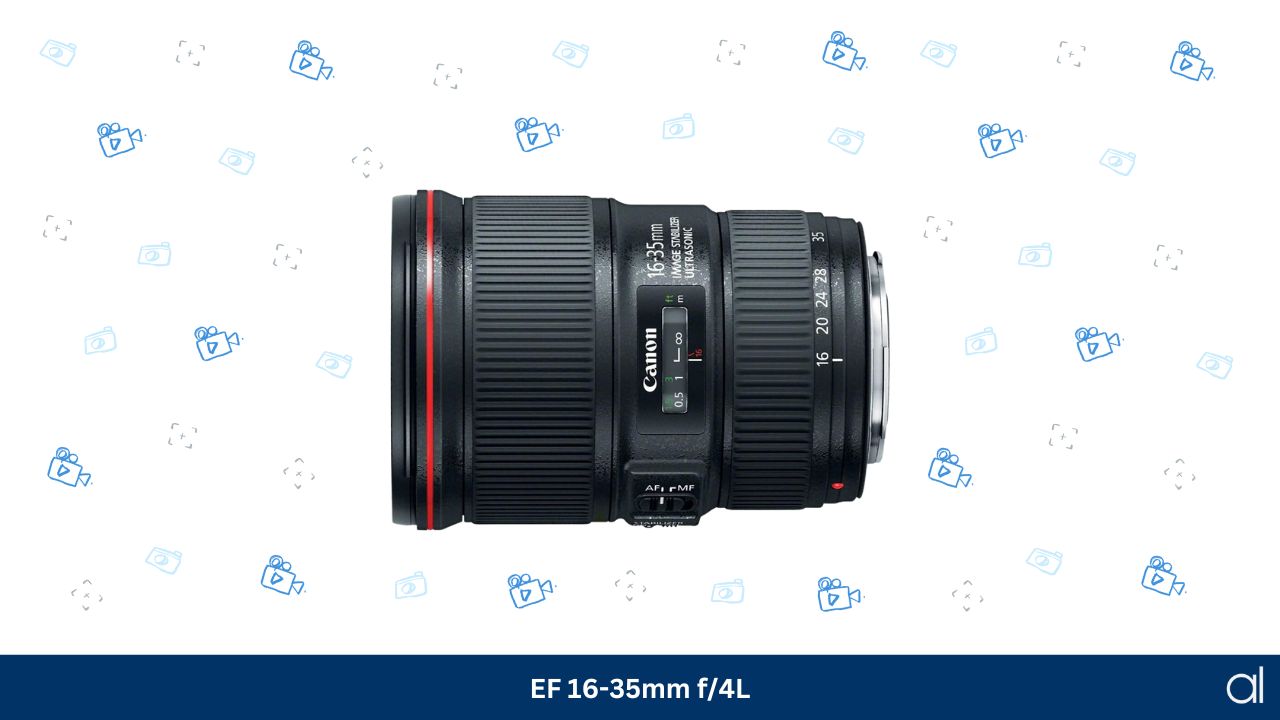Photographing architecture is a fine balance of technical expertise and artistic vision. And with the best lens in your arsenal, you can capture the grandeur, symmetry, and intricate details that define these architectural marvels.
In this article, I present to you my handpicked selection of the absolute best Canon lenses for architectural photography.
Best Canon Lenses
1. EF 17-40mm 8806A002 – Best For Ultra Wide Angles
The EF 17-40mm 8806A002 lens is a part of Canon’s prestigious L-series, so you know you’re getting your hands on a top-notch construction. It feels solid and sturdy in the hands, and it’s also weather sealed, which makes it perfect for outdoor architectural photography.
The focal length range of 17-40mm gives you that ultra-wide perspective, perfect for capturing grand architectural structures. The constant f/4 maximum aperture allows for consistent exposure throughout the zoom range.
Plus, with the use of three aspheric lens elements and a super UD glass, the optics are truly exceptional. Based on my tests, the images taken with this wide-angle lens are incredibly sharp and detailed.
One thing to note is that there is a bit of distortion, but that’s expected with a wide-range angle. However, it can easily be corrected in post-processing, so it’s not a deal breaker.
The autofocus of this ultra-wide angle lens is fast and accurate. It’s equipped with Canon’s USM (Ultrasonic Motor), which ensures silent and smooth focusing.
In terms of image stabilization, it is not built into this lens. However, if your camera body has IS capabilities, you can still benefit from it.
The lens comes with a leather lens bag and hood. And here’s the cool thing: you can select either screw-in 77mm filters or a gel photographic filter holder at the rear of this lens. And one more thing. This lens is compatible with a full-frame DSLR, so if you are planning to upgrade in the future, you’ll be all set. Just be mindful when shooting in low light conditions, as the f/4 aperture might require some extra lighting.
What I Liked
- Ultra-wide perspective
- Compatible with full-frame DSLR
- Three aspheric lens
- Weather sealed
What I Didn’t Like
2. RF14-35mm 4857C002 – Best For Close Focusing Capacity
The Canon RF14-35mm F4 L USM lens delivers incredible sharpness and detail thanks to its L-series optical construction. After giving it a go, the images I could capture with this lens are stunning, with rich colors and impressive clarity. However, I have noticed that the lens could look less sharp at some focal lengths.
The Canon RF14-35mm offers a versatile focal length of 14mm to 35mm, allowing you to capture a wide perspective. Whether you are shooting expansive landscapes or capturing the intricate details of architectural structures, this lens has got you covered.
After trying it in various situations, I found the close focusing capacity down to about 7.9 inches. It allows you to capture close-up shots with great detail.
Canon has also incorporated their SWC (Subwavelength structure coating) and ASC (Air sphere coating) into this lens. These coatings help reduce lens flare and ghosting, ensuring that your images have excellent contrast and clarity even in challenging light conditions.
Talking about the aperture, the lens maintains a constant f/4 aperture throughout the zoom range, which is fantastic for consistent exposure and creative control over depth. Again, it may not be the widest aperture available, but it still performs admirably in most architectural photography situations.
What I Liked
- SWC and ASC coating
- Wide perspective
- Focal length of 14mm to 35mm
- Rich colors and impressive clarity
What I Didn’t Like
3. 17mm TS-E 3553B002 – Best For Precise Control Over Perspective
The Canon TS-E f/4L UD Aspherical Ultra Wide Tilt-Shift Lens features a tilt-shift mechanism. It is one of the widest tilt-shift lenses available in the brand’s lineup, offering a whole new level of creative control. With the ability to tilt as well as shift this lens for architectural photography, you can achieve incredible perspective control and create stunning landscape shots photographing architecture.
The manual focus adjustment is smooth, which is crucial when working with tilt and shift movements. The lens boasts a wide focal length of 17mm, providing a wide-angle view of 93 degrees. This wide perspective allows you to capture expansive scenes with breathtaking detail and depth. Plus, the lens elements have high precision, and aspherical UD glass ensures exceptional quality.
The coated aspherical elements, combined with super-spectra coatings and a sub-wavelength structure coating, deliver the highest possible glare-free image quality. You can expect sharpness, clarity, and low perspective distortion from the center to the edges of the photograph.
The Canon TS-E 17mm also features an improved tilt-shift knob with an enhanced range of movement up to +/- 6.5 degrees. Based on my first-hand experience, this increased range allows for more precise adjustments, giving you greater control over your composition and focus. Now, it’s important to mention that using filters with this tilt-shift lens can be a challenge due to its bulbous front element. The unique design limits the use of screw-on filters, so you’ll need to explore alternative filter solutions if you rely heavily on filters in your tilt–shift photography.
What I Liked
- Aspherical Ultra Wide Tilt-Shift Lens
- Glare-free image quality
- Coated aspherical elements
- Movement up to +/- 6.5 degrees
What I Didn’t Like
4. EF-S 18-55 1620C002 – Best For Lightweight And Compact Design
The Canon EF-S 18-55mm f/4-5.6 STM is a perfect companion for Canon EF lens mount cameras, delivering great performance in a compact and lightweight package.
With a focal length range of 18 to 55mm, it can cover a wide range of architectural photography scenarios. The lens incorporates a lead-screw type stepping motor (STM) that ensures smooth and quiet autofocus, making it ideal for both photos and videos.
The camera lens also features a multi-coated lens coating, resulting in sharp images. Based on my observations, the compact and non-retracting body of the lens makes it easy to carry around, and the platinum ring behind the zoom ring adds a touch of elegance to its design.
This zoom lens also offers image stabilization, which provides up to 4 stops of shutter speed compensation. This means you can capture clearer details in low-light situations without having to use a tripod, increase the ISO, or decrease the shutter speed, reducing the chances of blurry images.
What I Liked
- Offers image stabilization
- Compact and non-retracting body
- Lead-screw type stepping motor (STM)
- Smooth and quiet autofocus
What I Didn’t Like
5. EF-M 22mm 5985B002 – Best For Capturing Moderate-wide Angles
The Canon EF-M 22mm f/2 STM compact system lens is made for Canon’s EF-M mount. It offers a moderate wide-angle focal length of 22mm. The lens features a maximum aperture of f/2, allowing you to achieve a shallow depth and create beautifully soft-focus backgrounds, giving your images a professional look.
It is equipped with a built-in stepping motor (STM) and continuous autofocus capability. This ensures smooth and quiet focusing, which is especially beneficial for video recording or situations where silence is important. It also has a short minimum focusing distance of only 5.9 inches, allowing you to get up close and capture detailed shots of your subject.
In terms of construction, the Canon EF-M 22mm lens is built with 7 elements in 6 groups and gives a diagonal angle of view, delivering sharp and high-quality images. This lens also features a circular aperture with 7 blades to help create pleasing and smooth bokeh in out-of-focus areas.
What I Liked
- Maximum aperture of f/2
- Built-in stepping motor (STM)
- Circular aperture with 7 blades
- Wide-angle focal of 22mm
What I Didn’t Like
6. EF 135mm f/2L USM Lens 2520A004 – Best For Large f/2 Aperture And Soft Bokeh Effect
The Canon EF 135mm f/2L USM is a telephoto lens designed for Canon SLR cameras. It has a focal length of 135mm and a fast maximum aperture of f/2.0, perfect for various architecture photography applications, including building photography, landscape photography, panoramic photography, macro photography, and street photography.
The large aperture allows for excellent depth control and helps to create a beautiful blur, or bokeh, making your subject stand out.
The Canon EF 135mm f/2L USM Lens features high-quality construction and optical aberration, as expected from Canon’s L-series lineup. It consists of 10 elements in 8 groups, including ultra-low dispersion glass with Fluorite elements, ensuring sharpness and minimizing chromatic aberrations. This telephoto prime lens also features SuperSpectra coatings for improved contrast and color accuracy.
It also has a fast and quiet autofocus system, thanks to the Micro UltraSonic Motor (USM). As indicated by my tests, this allows for precise and quick focusing, making it ideal for capturing fast-moving objects as well as ensuring sharpness in architectural photography. Also, it comes with a soft case and a lens hood to protect and enhance your architectural photography experience.
The lens has a minimum focusing distance of 3 feet, allowing you to get close to your subject while maintaining a flattering perspective. The lens also features a circular aperture, which contributes to the pleasing and smooth bokeh that is often desired in architectural photography.
What I Liked
- Excellent depth control
- Minimum focusing distance of 3 feet
- Flattering perspective
- SuperSpectra coatings
What I Didn’t Like
7. EF 24-70mm 5175B002 – Best For Minimized Chromatic Aberration
The Canon EF 24-70mm f/2.8L II USM standard zoom lens offers a focal length range of 24-70mm and a bright maximum aperture of f-number 2.8. It is well suited for a wide range of architectural photography genres, including landscape, cityscape, street, buildings, portraits, and more. The 24mm wide angle allows you to capture expansive scenes, while the 70mm focal length allows for close-up shots.
The Canon EF 24-70mm f/2.8L II USM lens features a robust construction with 18 elements in 13 groups. It incorporates one Super UD lens element and two UD lens elements, which helps minimize chromatic aberrations and maintain color balance. The optical lens design and construction, coupled with optimized lens coatings, ensures sharpness, contrast, and accurate color representation in every shot.
It also features a rotating zoom system and a zoom lock lever, allowing you to secure the lens at the desired focal length and prevent any unwanted zoom creep.
The lens utilizes Canon’s Advanced Ring-Type UltraSonic Motor (USM) for fast, precise, and silent autofocus. This allows you to capture fleeting moments with ease and accuracy, whether you are a photographer shooting stills or recording videos. The inner focusing design further enhances autofocus performance, ensuring consistent results even at close focusing distances.
What I Liked
- Ring-Type UltraSonic Motor (USM)
- 24mm wide angle
- Robust construction
- Rotating zoom system
What I Didn’t Like
8. EF 70-200mm 2751B002 – Best For Telephoto Zoom
The Canon EF 70-200mm f/2.8L IS II USM telephoto zoom lens is popular among professional photographers and enthusiasts alike thanks to its impressive performance and versatile focal length range.
With a maximum aperture of f/2.8, this lens allows for excellent low-light performance and creates a beautiful shallow depth of field, making it ideal for various photography genres, including architectural photography.
The 70-200mm focal range provides flexibility, allowing you to capture both distant objects and closer details with ease.
The Canon EF 70-200mm f/2.8L IS II USM lens features a robust construction consisting of 23 elements in 19 groups. This optical design includes one fluorite element and five UD (Ultra Low Dispersion) elements to improve the overall image quality and enhance sharpness and contrast.
The lens incorporates Canon’s advanced Image Stabilization (IS) Technology, which provides up to 4 stops of correction for camera shake. This is particularly beneficial when shooting handheld or in challenging lighting conditions, as it allows you to capture sharp and blue-free images. The IS system can be further enhanced when used in combination with cameras featuring in-body stabilization.
The lens utilizes Canon’s Ring-type UltraSonic Motor (USM) for fast, accurate, and quiet autofocus performance. Additionally, it provides full-time manual focus override, allowing you to make precise adjustments manually without switching out of autofocus mode.
Measuring 77mm in filter size, this lens is compatible with various filters, allowing you to further enhance the quality. It also supports the use of Canon’s Extender EF teleconverters, which provide additional focal length and versatility while maintaining image quality.
What I Liked
- Canon’s Ring-type UltraSonic Motor (USM)
- 77mm filter
- Supports Canon’s Extender EF teleconverters
- 4 stops of correction
What I Didn’t Like
9. EF 16-35mm f/4L 9518B002 – Best For Excellent Color Balance And Full-time Manual Focus Option
The Canon EF 16-35mm f/4L wide-angle zoom lens is designed to deliver exceptional image quality and versatility for Canon EF mount cameras.
Featuring a focal length of range 16-35mm, this lens is well suited for a variety of photography genres. With a maximum aperture of f/4.0, it allows for good low-light performance and provides a desirable depth of field for creative compositions.
The lens construction consists of 16 elements in 12 groups, including three aspherical lens elements to minimize distortion and improve image sharpness.
The Canon EF 16-35mm f/4L IS USM lens incorporates Canon’s Ring-type Ultrasonic Motor (USM) for fast, accurate, and quiet autofocus performance. It also features full-time manual focus, allowing for precise adjustments even when in autofocus mode.
It even has a full-time manual focus, allowing for precise adjustments when in autofocus mode. This lens is equipped with Dual Pixel CMOS AF, covering approximately 100% of the frame with 1,053 autofocus areas, ensuring quick and accurate focusing, especially when used with Canon cameras that support this technology.
With a closing focusing distance of 0.92 ft. (0.28m), this lens allows for close-up shots with a wide-angle perspective, adding versatility. And the 9-blade rounded diaphragm contributes to pleasing bokeh and smooths out-of-focus areas.
What I Liked
- Closing focusing distance of 0.92 ft
- 9-blade rounded diaphragm
- Equipped with Dual Pixel CMOS AF
- 1,053 autofocus areas
What I Didn’t Like
Best Canon Lens Comparison Table
| Cannon Lenses | Lens Type | Compatible Mountings | Lens Design | Focus Type |
|---|---|---|---|---|
| EF 17-40mm 8806A002 | Wide Angle | Canon EF | Zoom | Auto Focus |
| RF14-35mm 4857C002 | Wide Angle | Canon RF | Zoom | Auto Focus |
| 17mm TS-E 3553B002 | Wide Angle | Canon EF | Prime | Manual Focus |
| EF-S 18-55 1620C002 | Normal | Canon EF-S | Zoom | Auto Focus |
| EF-M 22mm 5985B002 | Normal | Canon EF-M | Prime | Stepper Motor |
| EF 135mm f/2L USM Lens 2520A004 | Telephoto | Canon EF | Prime | UltraSonic |
| EF 24-70mm 5175B002 | Wide Angle | Canon EF | Zoom | Ring-type ultrasonic |
| EF 70-200mm 2751B002 | Telephoto | Canon EF | Zoom | Manual Focus |
| EF 16-35mm f/4L 9518B002 | Wide Angle | Canon EF | Zoom | Ring-type ultrasonic |
Buying Guide For The Best Canon Lens
1. Focal Length
In architectural photography, the focal length of a lens plays a vital role in determining the perspective and visual impact of your photographs. Wide-angle lenses are commonly favored for capturing expansive scenes, emphasizing space, and showcasing the grandeur of architectural structures. Canon offers a range of wide-angle lenses that are well-suited for architectural photography.
If you prefer more versatility in focal lengths, zoom lenses can be a great choice. They cover a focal range from wide-angle to moderate wide-angle, allowing you to adjust the composition without changing lenses. This flexibility can be advantageous when shooting in dynamic environments and when you need to capture different perspectives without interruption.
Consider your photography style, the size of architectural structures you typically photograph, and the effect you want to achieve when deciding on focal length in lenses for architectural photography.
2. Aperture
Firstly, a wide aperture allows for shooting in low light conditions without the need for external continuous lighting. It enables you to gather more light, resulting in properly exposed images without having to rely on high ISO settings.
Secondly, a wide aperture offers the potential for achieving a shallow depth of field. By selecting a larger aperture, you can create a narrower plane of focus, selectively blurring the foreground or background elements while keeping the main subject sharp. This can be advantageous when you want to draw specific attention to detail or create a sense of separation and depth between foreground and background elements.
Furthermore, a wide aperture allows for creative control over the focus and background blur, commonly known as bokeh. It enables you to isolate specific elements and emphasize their importance by creating a visual separation from the surroundings.
3. Perspective Control
Perspective control is a crucial consideration in lenses for architectural photography, and specialized lenses known as tilt-shift lenses are particularly valuable in this regard. The tilt-shift lenses offer unique capabilities that allow photographers to correct and control perspective distortion, resulting in more accurate representations of architectural structures.
In architectural photography, perspective distortion often occurs when photographing tall buildings or capturing interiors with converging lines. This distortion can make vertical lines appear slanted or distorted, detracting from the intended aesthetic and architectural accuracy of the photograph. A tilt-shift lens addresses this issue by providing independent control over the tilt and shift movements of the lens elements.
By tilting the tilt-shift lens, you can correct the perspective distortion caused by converging lines, ensuring that vertical lines remain parallel and upright. And by shifting the tilt-shift lens, you can expand the field of view while keeping the camera level, thereby maintaining accurate vertical lines and preventing the typical leaning effect that occurs when tilting the camera upwards.
What are the benefits of using a wide-angle lens for architectural photography?
Ultra-wide lenses allow you to capture a broader perspective and include more of the building or structure in the frame. They are ideal for capturing architectural details and interiors to highlight the overall context of the environment.
How does lens choice impact architectural photography?
The lens you choose has a significant impact on your architectural photography. Wide-angle lenses can capture more of the scene and allow for dramatic perspectives, while tilt-shift lenses enable you to correct perspective distortion and maintain straight lines.
How can I ensure compatibility between a lens and my Canon camera?
Ensure compatibility by checking the manufacturer’s specifications or consulting a professional. Canon produces lenses with different mounts, such as EF, EF-S, RF, and EF-M mounts.
What is the importance of lens aperture in architectural photography?
Lens aperture plays a crucial role in architectural photography. A wider aperture (lower f-stop value) allows more light to enter the lens, enabling faster shutter speeds and better performance in low-light conditions.
It also provides a shallow depth of field, which can be useful for isolating specific elements in architectural compositions.
Is a tilt-shift lens necessary for architectural photography?
Canon’s L series lenses are known for their top performance and professional-grade construction. They generally offer exceptional image quality and additional features.
Tilt-shift lenses are not necessary, but they offer unique perspective control and distortion correction capabilities, making them highly advantageous for architectural photography.
Can tilt-shift lenses be used for more than just architectural photography?
While tilt-shift lenses are often associated with architectural photography, their versatility extends beyond that genre. These lenses can be creatively employed in various fields, such as product photography, portraiture, and even landscape photography.
Their unique control over perspective and depth of field allows photographers to experiment with selective focus, creative blur effects, and unique compositions.
Are there any specific considerations for capturing interior shots in architecture?
When capturing interior shots in architecture, it’s recommended to use ultra-wide lenses to capture the expansive space. Additionally, paying attention to lighting, composition, and the elimination of distortion can help showcase the interior effectively.
Conclusion
Well, you are now well equipped with knowledge about a range of Canon lenses suitable for architectural photography. And to make it easier for you to choose one of these, let’s bring this discussion to a close with my top picks for the best lenses.
First on my list is the EF 17-40mm 8806A002. It uses three aspherical lens elements to minimize distortions and strikes the perfect balance between wide-angle perspectives and versatile zoom capabilities, making it a solid choice.
Next up, you have the RF14-35mm 4857C002. Designed for Canon’s RF mount, this lens boasts incredible image quality in a compact design. With its wide angled range of 14mm to 35mm, it covers a broad field of view, ideal for capturing expansive architectural structures.
It’s time to grab your camera, attach your chosen lens, and get ready to click on the architectural wonders around you.
Related Articles
5 Best Lenses for Street Photography
19 Best Lenses for Landscape Photography
7 Best Lenses for Building Photography
13 Best Continuous Lighting Kits for Photography

